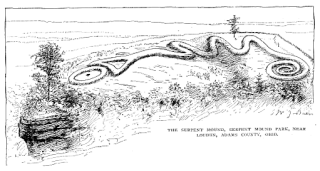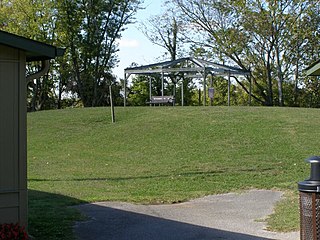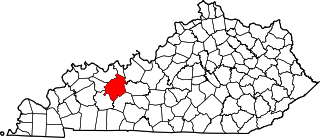
In the classification of the archaeological cultures of North America, the Archaic period in North America, taken to last from around 8000 to 1000 BC in the sequence of North American pre-Columbian cultural stages, is a period defined by the archaic stage of cultural development. The Archaic stage is characterized by subsistence economies supported through the exploitation of nuts, seeds, and shellfish. As its ending is defined by the adoption of sedentary farming, this date can vary significantly across the Americas.

Wickliffe Mounds is a prehistoric, Mississippian culture archaeological site located in Ballard County, Kentucky, just outside the town of Wickliffe, about 3 miles (4.8 km) from the confluence of the Ohio and Mississippi rivers. Archaeological investigations have linked the site with others along the Ohio River in Illinois and Kentucky as part of the Angel phase of Mississippian culture. Wickliffe Mounds is controlled by the State Parks Service, which operates a museum at the site for interpretation of the ancient community. Listed on the National Register of Historic Places, it is also a Kentucky Archeological Landmark and State Historic Site.

The Adena culture was a Pre-Columbian Native American culture that existed from 500 BCE to 100 CE, in a time known as the Early Woodland period. The Adena culture refers to what were probably a number of related Native American societies sharing a burial complex and ceremonial system. The Adena culture was centered on the location of the modern state of Ohio, but also extended into contiguous areas of northern Kentucky, eastern Indiana, West Virginia, and parts of extreme western Pennsylvania.
The Angel phase describes a 300–400-year cultural manifestation of the Mississippian culture of the central portions of the United States of America, as defined in the discipline of archaeology. Angel phase archaeological sites date from c. 1050 - 1350 CE and are located on the northern and southern sides of the Ohio River in southern Indiana, such as National Historic Landmark Angel Mounds near present-day Evansville; northwestern Kentucky, with Wickliffe Mounds and the Tolu Site; and Kincaid Mounds State Historic Site in Illinois. Additional sites range from the mouth of Anderson River in Perry County, Indiana, west to the mouth of the Wabash in Posey County, Indiana.

Bannerstones are artifacts usually found in the Eastern United States that are characterized by a centered hole in a symmetrically shaped carved or ground stone. The holes are typically 1⁄4" to 3⁄4" in diameter and extend through a raised portion centered in the stone. They usually are bored all the way through but some have been found with holes that extend only part of the way through. Many are made from banded slate or other colored hard stone. They often have a geometric "wing nut" or "butterfly" shape but are not limited to these. More than just functional artifacts, bannerstones are a form of art that appear in varying shapes, designs, and colors, symbolizing their ceremonial and spiritual importance.
The Green River Shell Middens Archeological District is a historic district composed of archaeological sites in the U.S. state of Kentucky. All of the district's sites are shell middens along the banks of the Green River that date from the later portion of the Archaic period. Studies of this assemblage of sites were critical in the development of knowledge of the Archaic period in the eastern United States.

Leary Site, also known as 25-RH-1 or Leary-Kelly Site is an archaeological site near Rulo, Nebraska and the Big Nemaha River. The site now lies entirely on the reservation of the Iowa Tribe of Kansas and Nebraska. The area was once a village and burial site.

This is a list of the National Register of Historic Places listings in Ohio County, Kentucky.

The Marshall Site (15CE27) is an Early Mississippian culture archaeological site located near Bardwell in Carlisle County, Kentucky, on a bluff spur overlooking the Mississippi River floodplain. The site was occupied from about 900 to about 1300 CE during the James Bayou Phase of the local chronology and was abandoned sometime during the succeeding Dorena Phase. Its inhabitants may have moved to the Turk Site, which is located on the nearest adjacent bluff spur to the south, and which was founded about this time. It is several miles south of the Wickliffe Mounds Site.
Stone box graves were a method of burial used by Native Americans of the Mississippian culture in the Midwestern United States and the Southeastern United States. Their construction was especially common in the Cumberland River Basin, in settlements found around present-day Nashville, Tennessee.
The Sixtoe Mound site (9MU100) is an archaeological site in Murray County, Georgia excavated by Arthur Randolph Kelly from 1962-1965 as a part of the Carters Dam project conducted for the National Park Service by the University of Georgia. The site consisted of a low platform mound and an associated village. The majority of the mound was excavated, while the village received little excavation.

The Prather Site (12CL4) is a Middle Mississippian culture archaeological site located in the Falls of the Ohio region in Clark County, Indiana. It was the principal ceremonial center of the Prather Complex, the northeasternmost regional variant of the Mississippian cultures. It also bordered on several Upper Mississippian cultures, including the Fort Ancient peoples of Southern Indiana, Southern Ohio and Northeastern Kentucky.

The Freel Farm Mound Site (40AN22) is an archaeological site and burial mound of the Late Woodland period located on the Oak Ridge Reservation in Oak Ridge, Tennessee. The site was excavated in 1934 as part of the Norris Basin Survey by the Tennessee Valley Authority using labor from the Civil Works Administration under the supervision of T.M.N. Lewis. Important finds of the excavation include 17 burials and a few artifacts. The artifacts and records from the fieldwork are held by the McClung Museum in Knoxville, Tennessee.
The Freel Farm Mound Site (40AN22) is an archaeological site and burial mound of the Woodland cultural period located on the Oak Ridge Reservation in Oak Ridge, Tennessee. The site was excavated in 1934 as part of the Norris Basin Survey by the Tennessee Valley Authority using labor from the Civil Works Administration under the supervision of T.M.N. Lewis. Important finds of the excavation include 17 burials and a few artifacts. The artifacts and records from the fieldwork are held by the McClung Museum in Knoxville, Tennessee.
The Carlston Annis Shell Mound is a prominent archaeological site in the western part of the U.S. state of Kentucky. Located along the Green River in Butler County, this shell midden has been declared a historic site because of its archaeological value.

The Hidden Valley Rockshelter (44-BA-31) is a significant archaeological site located near the community of Warm Springs in Bath County, Virginia, United States. A large rockshelter located near the Jackson River, it has been occupied by humans for thousands of years, and it has been named a historic site.
Dewil Valley, located in the northernmost part of Palawan, an island province of the Philippines that is located in the Mimaropa region, is an archaeological site composed of thousands of artifacts and features. According to the University of the Philippines Archaeological Studies Program, or UP-ASP, the closest settlement can be found in New Ibajay, which is covered by the town capital of El Nido, which is located around 9 km (5.6 mi) south-east of Dewil Valley. Physically it measures around 7 km (4.3 mi) long, and 4 km (2.5 mi) wide. It is in this place which the Ille Cave, one of the main archaeological sites, can be found. It is actually a network of 3 cave mouths located at its base. It has been discovered that this site in particular has been used and occupied by humans over multiple time periods.
There are many sites within the Midwestern United States. Some of the better known sites are the Koster Site in Illinois, the Green River Valley in Kentucky, Hendricks Cave in Ohio, Indian Knolls and Dravo Gravel.
The Fisher Mound Group is a group of burial mounds with an associated village site located on the DesPlaines River near its convergence with the Kankakee River where they combine to form the Illinois River, in Will County, Illinois, about 60 miles southwest of Chicago. It is a multi-component stratified site representing several Prehistoric Upper Mississippian occupations as well as minor Late Woodland and Early Historic components.

Kadero is an African archaeological site located in Central Sudan, northeast of Khartoum, Sudan and east of the Nile River. The site consists of burial grounds and two sand mounds around 1.5 meters in elevation, altogether encompassing around three hectares. Excavations at the site were led by Lech Krzyżaniak at the University of Warsaw. Kadero was occupied during the Neolithic period, dating to the years 5960 through 5030 B.P specifically, by pastoralists. The inhabitants of Kadero left behind evidence of intensive pastoralism, which is the earliest evidence of such phenomena in the area. Analysis of ceramics and stone artifacts have led archaeologists to consider the site as comparable to other early Neolithic sites in central Sudan, such as Ghaba and R12, placing the site in the early Khartoum culture.













